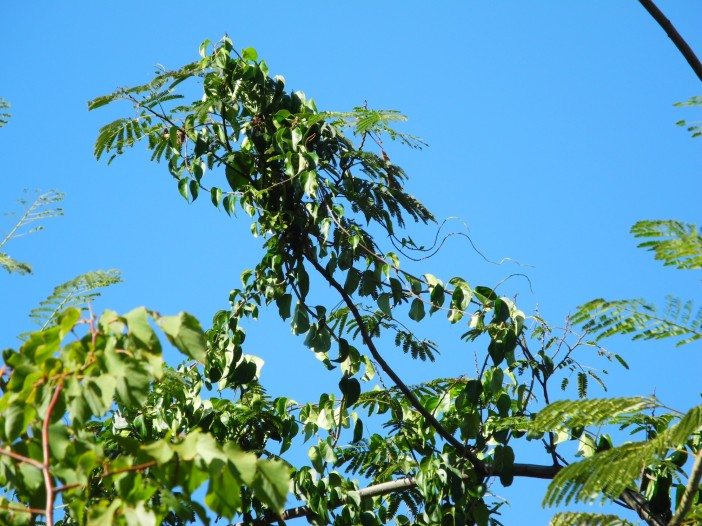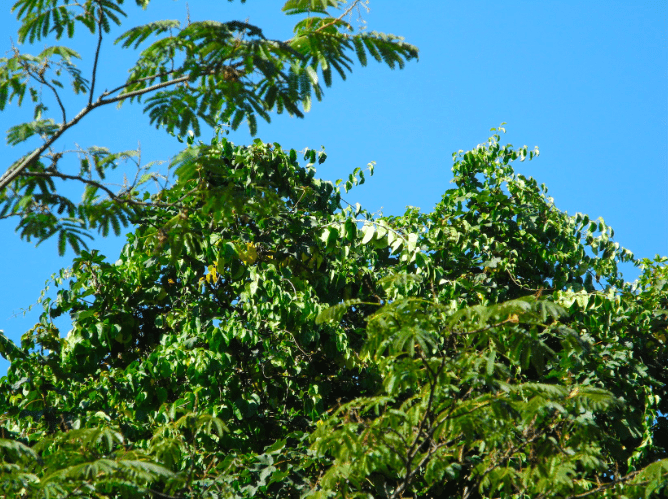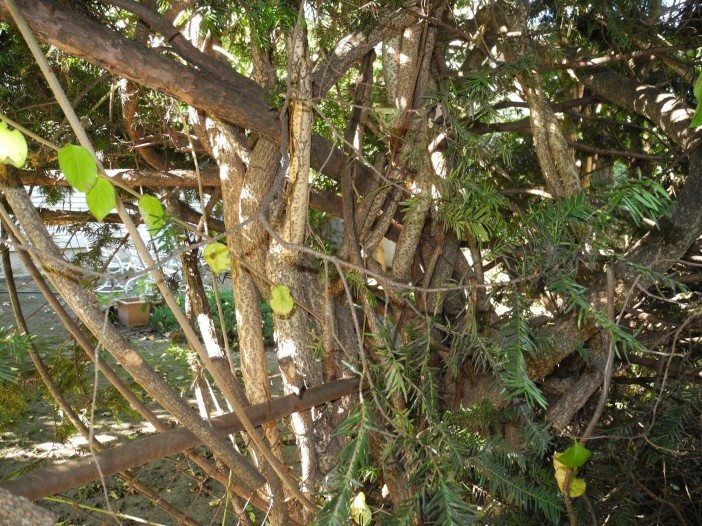Ditmas Park Perspective: Wrestling The Asian Bittersweet, A Backyard Vine With Issues


The inaugural Ditmas Park Perspective comes to us from neighbor John Epstein, who has lived in the area for the past 17 years. He documents the ongoing struggle of saving a beloved tree from an invasive vine, and details the characteristics (even, admittedly, some positives) of said vine.
You can read more about John below–and if you’d like to share your Ditmas Park Perspective, including your response to today’s topic, don’t hesitate to contact editor@ditmasparkcorner.com.
Ditmas Park Perspective posts are meant to reflect the opinions of individuals in our community, and do not necessarily reflect the opinions of Ditmas Park Corner. We hope this series will facilitate conversation between neighbors, but as per our general policy, no personal attacks or abusive, inflammatory, or profane comments will be permitted.
I moved into Ditmas Park West a couple of summers ago and fell instantly in love with a twenty-five foot mimosa tree that grew behind my neighbors’ garage. The sweet scent of the tree’s fragrant pink flowers permeated my backyard attracting bees, butterflies and the occasional ruby-throated hummingbird. But as the summer progressed, I began to notice a snake-like vine, with deep, spade-shaped leaves gradually twisting itself around the slender branches and delicate fern-like leaves of the mimosa. The aggressive plant was woody and cord-like and so relentless in its advance, that entire branches of the flowering tree were being severed.
The killer vine, celastrus orbiculatus, is commonly known as the Asian bittersweet. Landscapers introduced this super fast grower to America in the late 1800s to control erosion along newly cut railroad beds and roadways. Now it spreads across the land in a variety of environments, north to Maine, south to Louisiana and west to the Rockies. Along tree-lined highways nearby, such as the Bronx River Parkway and the Hutchinson River Parkway, Asian bittersweet is rampant, blanketing acres of woods. The vine has little red berries that birds love to eat. Unfortunately, they defecate the seeds far and wide helping to spread the insidious, green menace.

Maybe the Asian Bittersweet isn’t as bad as the man-eating plant in Little Shop of Horrors, but here in Ditmas Park it was making me terrified for the lives of the few trees that graced the backyards within eyeshot of mine. The old, flowering cherry tree belonging to Daniel, the neighbor immediately behind my house, had been reduced by the tenacious tendrils of the bittersweet to a blasted trunk and a few palsied branches. Looking north a few houses over, I gazed with dread fascination at a forty-foot maple tree — its highest branches about to turn autumn orange — being pulled down by the boa constrictor reach of the ubiquitous vine.
What was to be done? First I needed to find the root of this evil or at least the main trunk. The likely location was near the backyard of my neighbors, Mike and Elise, the owners of the mimosa. Mike and I did a quick investigation and found a large yew tree in the yard behind his place that was choking to death under the onslaught of wood vines as thick as a human leg. This was plainly the source vine and getting rid of it was no simple task; it would take a chain saw to hack through the thick base.
Rebecca, the lady of the house where the big vine resides, immediately accepted my offer to destroy or at least cut back the unwelcome vine. But my initial attempts at the task met with extreme difficulty. I started by yanking and slashing scores of the octopus tendrils which were destroying the mimosa. But a day or so later I could see that this technique was a dubious success. Dead vine leaves were drooping amidst the green fronds of the mimosa, not exactly a pleasing sight, I had to admit to another neighbor.
So I set to work again, now doing an imitation of a Harold Lloyd skit, dancing around on the roof of a garage, hanging from trees, leaning on utility poles, and using a variety of long-handled cutting tools I had acquired at yard sales. The result: the mimosa was freed from not only the vines but their dead leaves, too, and I bagged the detritus for the trash.

The mother trunk of the Asian bittersweet still remains a problem — pulling away vines from tree limbs twenty to forty feet above the ground is not recommended for amateurs. Yet to allow the vine to grow unfettered throughout the neighboring backyards would eventually result in the death of precious shade trees, and there is a huge risk during nor’easters and hurricanes when the leaves on the vines can catch the high winds like a sail generating enough force to a topple a tree.
The Asian bittersweet is not a total environmental or aesthetic negative. Indeed, there are some benefits. In addition to providing food for birds, the jumbled vines harbor other wild life. I once heard a huge fight between an opossum and a raccoon within the vine’s jungle-like canopy. The wall of green created by the vines also can provide privacy for people. I hear that some folks like to gather up the red berry-laden vines to make decorative wreaths.
But trees, hedges and shrubs free of parasitical vines also provide animal havens and privacy, all without the environmental risks posed by the Asian bittersweet. I suggest a middle ground in the neighborhood: the cutting of the vine at its base during winter or early spring, thereby avoiding the unsightly, dead-leaf effect, yet arresting the noxious plant’s further impact on the remaining, more desired greenery.
John Epstein is a lawyer and writer who lives in Ditmas Park with his wife, Joanna Hefferen, their daughter, Nell, and two cats — Alice and Trixie. They have lived in the neighborhood at different locations since 1997, having emigrated from Park Slope. John became interested in gardening at the age of seven while living on a farm near the Potomac River in West Virginia. When not planting bulbs, he can be seen riding his bicycle to the nearby Knickerbocker Field Club to play tennis.



